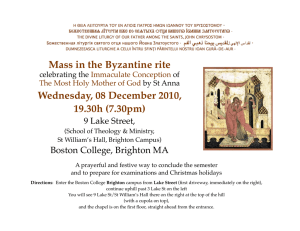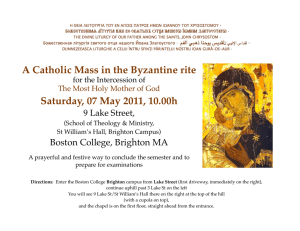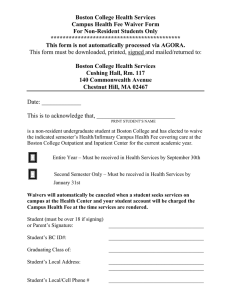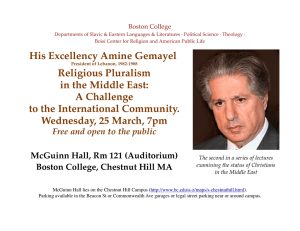Executive Summary
advertisement
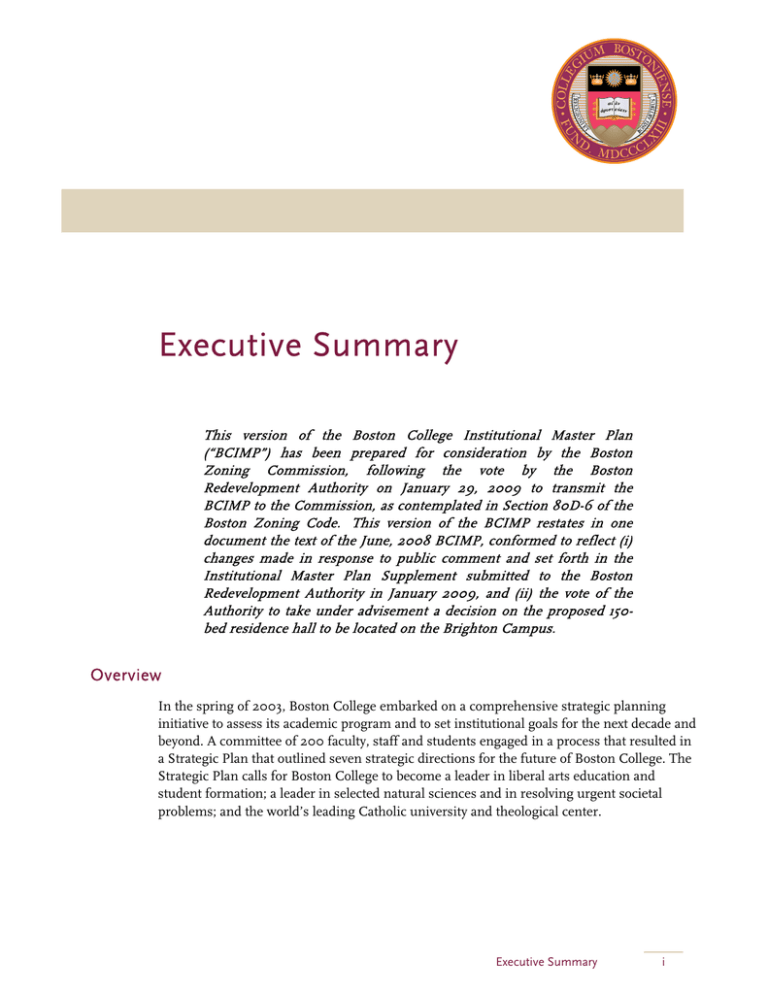
Executive Summary This version of the Boston College Institutional Master Plan (“BCIMP”) has been prepared for consideration by the Boston Zoning Commission, following the vote by the Boston Redevelopment Authority on January 29, 2009 to transmit the BCIMP to the Commission, as contemplated in Section 80D-6 of the Boston Zoning Code. This version of the BCIMP restates in one document the text of the June, 2008 BCIMP, conformed to reflect (i) changes made in response to public comment and set forth in the Institutional Master Plan Supplement submitted to the Boston Redevelopment Authority in January 2009, and (ii) the vote of the Authority to take under advisement a decision on the proposed 150bed residence hall to be located on the Brighton Campus. Overview In the spring of 2003, Boston College embarked on a comprehensive strategic planning initiative to assess its academic program and to set institutional goals for the next decade and beyond. A committee of 200 faculty, staff and students engaged in a process that resulted in a Strategic Plan that outlined seven strategic directions for the future of Boston College. The Strategic Plan calls for Boston College to become a leader in liberal arts education and student formation; a leader in selected natural sciences and in resolving urgent societal problems; and the world’s leading Catholic university and theological center. Executive Summary i In November of 2003, the Archdiocese of Boston forever altered the Brighton neighborhood when it revealed that it was selling most of its 65-acre Brighton Campus to meet its financial obligations. After discussions with real estate developers who expressed interest in the property for commercial use or housing, the Archdiocese announced in May, 2004 that it would sell 43.5 acres to Boston College. In subsequent transactions in 2006 and 2007, Boston College purchased the remaining land for a total of $172 million. With the acquisition of this much-needed property across Commonwealth Avenue, Boston College was presented with an historic opportunity to address space issues that had hindered its campus for decades, and to develop the University in a way that would fulfill its Strategic Plan and its academic mission of fostering the intellectual development and the religious, ethical and personal formation of its students. To assist in this undertaking, Boston College hired Sasaki Associates of Watertown, one of the nation’s leading campus architecture and planning firms, to help develop a comprehensive campus plan. During this process, the University established six guiding principles essential to fulfilling its institutional objectives: 1. Create One Campus—That the former Archdiocesan property become fully integrated with the Boston College campus, and that the 118-acre Chestnut Hill Campus, the 40-acre Newton Campus and the 65-acre Brighton Campus each provide a notable setting that contributes to the campus learning environment and the life of the University. 2. Develop Mixed Campus Uses—That Boston College’s campuses host a mix of academic, residential and co-curricular facilities, and provide civic, spiritual and openspace areas that foster a vibrant and engaged University community. 3. Emulate the Character of the Middle Campus—That the new facilities on the Lower and Brighton campuses reflect the distinctive character of the Middle Campus with its combination of Gothic architecture and collegiate open spaces, linked quadrangles and walkways. 4. Provide Appropriate Campus Density—That campus development emulate the Middle Campus’ proportion of open space to building space, reflecting the Middle Campus height (4-5 stories) and open-space pattern, while respecting the character of the surrounding community. 5. Promote Student Formation—That the Lower and Brighton campuses develop undergraduate student housing reflecting the University’s commitment to student formation that supports intellectual development and responsible student behavior in smaller living communities. 6. Achieve Sustainability—That development on each campus achieve higher levels of energy efficiency and champion the natural environment, and that sustainability goals be carefully considered with each project. In February, 2006, Boston College proposed to its Board of Trustees its 10-year, $1.6 billion Strategic Plan that called for hiring additional faculty, adding new academic centers and ii Executive Summary Institutional Master Plan institutes, and building the facilities needed to meet the University’s most pressing needs. After careful review, the Board of Trustees approved the proposal unanimously. Institutional Master Plan Background Throughout 2006 and 2007, the University participated in monthly meetings with the Boston College Allston-Brighton Community Task Force, neighbors and elected officials to provide information on its plans. After two years of community meetings, during which one BRA official praised BC’s efforts as a model Master Plan process, Boston College submitted its Institutional Master Plan Notification Form (IMPNF) to the Task Force and the City of Boston on December 5, 2007. Following the BRA Scoping Determination issued in February 2008 and an additional six months of public process, Boston College submitted the Institutional Master Plan (IMP) to the Task Force and BRA in June 2008. Following additional Task Force and BRA public meetings, the BRA Board approved the plan, as modified by the Boston College Institutional Master Plan Supplement, on January 29, 2009, while taking under advisement for future deliberation by the Authority the proposed 150-bed residence hall for the north side of Commonwealth Avenue on the Brighton Campus. This 150-bed project is not under consideration by the Zoning Commission at this time. The 10-year Institutional Master Plan as approved by the BRA Board contains the following major elements on property in the City of Boston: A 200,000 sf Recreation Center replacing the outdated Flynn Recreation Complex, with fitness equipment, pool, jogging track, basketball courts and multi-purpose rooms on St. Thomas More Road on Lower Campus at the present site of Edmonds Hall. A 285,000 sf University Center on Lower Campus to accommodate BC’s 230 student organizations, provide dining and conference space for students and faculty, allow for the expansion of theater space and provide key support for the University’s student formation goals. A net total of 790 new beds1 of undergraduate student housing that would increase the total of BC students living on campus to 94 percent of demand. The construction of 550 beds on Shea Field, 470 beds on the current More Hall site and the addition of 560 beds at 2000 Commonwealth Avenue would enable the replacement of the 36-year old 1 If the BRA Board takes a future vote to approve the 150 new beds that were taken under advisement at the January 29, 2009 BRA public meeting, and the Boston Zoning Commission subsequently approves such amendment to this IMP, the net number of beds of undergraduate student housing approved in the amended IMP will total 940 which would increase the total of BC students living on campus to 96 percent of demand. Executive Summary iii Edmonds Hall. The construction of 185 beds on Lower Campus will replace 185 beds in several modular housing units. A Brighton Athletics Center on the Brighton Campus, which would include a 1,000-seat baseball field and a 300-seat softball field, as well as a multi-purpose field for intramural sports and a 60,000 square foot support facility. A Fine Arts District on the Brighton Campus that would include the relocated McMullen Museum of Art, an auditorium and office space for the Fine Arts Department. The Fine Arts District would serve as an important gateway to the BC campus from the east. A 350-space addition to the Beacon Street Garage and a 500-space parking facility to serve the Brighton Campus. Utilization of the remaining properties acquired from the Archdiocese of Boston as administrative offices. In addition to the projects on property located in the City of Boston, the 10-year plan includes the following major elements on land in the City of Newton: Raze McElroy Commons on the Middle Campus in Chestnut Hill and create a new campus quadrangle and pedestrian walkway linking with other quadrangles connecting the Upper, Middle and Lower campuses. iv Executive Summary Institutional Master Plan Construct four new academic buildings on the Middle Campus in Chestnut Hill, including: Stokes Commons, an 85,000 square foot (sf) facility to be used as an interim student center and dining hall; a 125,000 sf facility for the humanities; a 75,000 sf facility for the Graduate School of Social Work and the Connell School of Nursing; and a 100,000 sf Institute for Integrated Sciences building, to support BC’s scientific research and teaching initiatives and to enhance collaboration among physics, chemistry and biology faculty. The Boston College IMP includes several mitigation commitments in addition to the projects described above. These actions include: No-Build Zone The University agrees to maintain a buffer zone of 50 feet in depth along Lake Street from Commonwealth Avenue to the St. John’s Hall driveway for a period of 25 years from the date of approval of the IMP. Property Acquisitions Boston College will notify appropriate individuals in the Mayor’s Office and the Boston Redevelopment Authority prior to a property purchase of $5 million or more in the City of Boston. Housing Restriction The University will propose, as part of its Institutional Master Plan Amendment for the 350-bed student residence, University efforts designed to eliminate occupancy by its students of one- and two-family houses in the 02134 and 02135 zip code areas, to become effective upon occupancy of the 350-bed residence hall. 2000 Commonwealth Avenue In order to plan for an orderly transition of the apartments at 2000 Commonwealth Avenue to student use, the University will phase the occupancy of this building as a residence to provide for full occupancy by 2012. Alternative Site Analysis for 350-bed Residence Hall Alternative sites for a proposed 350-bed residence hall on the Brighton Campus Library Parking Lot will be analyzed. Future approval of this specific project will require an amendment to the IMP. Construction of these 350 beds and the 150 beds taken under advisement by the Authority would allow Boston College to meets its goal of housing 100 percent of its undergraduate housing demand in University controlled housing. Mortgage Assistance Program The University agrees to establish a mortgage program to assist full time University faculty and staff to purchase homes in the Allston-Brighton neighborhood, thereby helping to reduce absentee ownership and promote neighborhood stability. Executive Summary v Athletics Advisory Committee Boston College will form an Athletics Advisory Committee to provide advice and comment on operational and management issues related to the Brighton Athletics Center including staffing, parking, pedestrian and vehicular access routes, sound, lighting and signage. The size and composition of the committee will be mutually agreed upon by the City of Boston, Boston College and the Allston-Brighton Boston College Community Task Force, and such details shall be addressed in the cooperation agreement entered into by the University and the BRA. Schedule of Use for Brighton Athletic Center Fields The University proposes a reduced schedule of use for the Brighton Athletics Center as detailed in Chapter 7. The fields will be used for varsity and intramural/club sports activities starting at 3 p.m., and informal use by BC individuals or groups when the fields are not reserved for organized activities. Brighton Athletics Center Lighting When fields are in use, lights will be dimmed at 9:30 p.m. and turned off at 10:00 p.m., except when a varsity game continues beyond those times. Intramural play on the Brighton fields will conclude by no later than 9:30 pm regardless of the status of play (i.e. mid-period or inning, if necessary). The University shall work closely with the Athletics Advisory Committee to monitor compliance with conditions applicable to such night play. To this end, the University shall produce periodic reports summarizing actual intramural lighting use and meet regularly with the Athletics Advisory Committee during the academic year to review such reports. If in any academic year, the reports evidence material, persistent violations by the University (defined as 10 percent or more of intramural games ending after 9:45 pm), Boston College shall be required to submit a remedial plan to the Athletics Advisory Committee, outlining additional conditions on lighting use designed to insure stricter compliance in the following academic year. Failure to submit such remedial plan may subject the University to further action by the City of Boston to enforce compliance with the light restrictions. Brighton Campus Access Boston College agrees to implement Brighton Campus Access Alternative 3 as shown in Figure 9-29. As part of this alternative, St. Thomas More Road access to Lake Street will remain open and a new access road to the Brighton Campus will be provided along the rear of the More Hall site. Transportation Demand Management Program Boston College will expand its TDM program with the following measures: ¾ Provide pre-tax MBTA pass sales for full time employees ¾ Provide a 25 percent MBTA pass subsidy for full time employees who forgo a campus parking permit vi Executive Summary Institutional Master Plan ¾ Investigate car-sharing opportunities on the Brighton Campus and offer spaces to Zipcar or a similar service as needed ¾ Provide bicycle storage at the new residence halls and parking garage on the Brighton Campus ¾ Regularly review the shuttle services offered by BC ¾ Purchase or lease alternative fuel vehicles Brighton Campus Parking The University agrees that the construction of its proposed 500-space parking garage on the Brighton Campus will commence after the completion of the first phase of University housing as approved by the Authority and the Zoning Commission. The Article 80 Large Project Review of this project will include a comprehensive review of the University’s overall transportation demand management programs and a detailed study of alternative parking strategies for the Brighton Campus. The scope of this study will include, at the minimum, updating the parking demand analysis, programs to improve alternate modes of transportation to reduce parking demand, additional site analyses which may result in distributing the parking spaces in multiple sites or an adjustment of the size and location of the garage. Conclusion After years of comprehensive strategic, campus and institutional planning, Boston College is submitting an Institutional Master Plan that it believes is in the best interest of the University and the local community it has served for the past 95 years. The 10-year plan, which calls for approximately 2.4 million square feet of new construction and approximately 600,000 square feet of demolition for a net gain of approximately 1.8 million square feet, reflects professional urban design principles, a commitment to sustainability and the latest research findings regarding residential housing and its effect on student formation. In addition, as Chapter 12 will describe in greater detail, the $1 billion in planned construction and renovation from the IMP will create an estimated 12,243 jobs and $737 million in labor income for local residents and provide a total 10-year economic impact of $1.57 billion. This economic impact will be in addition to the $1.3 billion annual economic impact of Boston College on the region as a whole. The Institutional Master Plan The following 13 chapters of the IMP contain the specific details outlined in this Executive Summary and respond directly to the various technical or programmatic information requested in the BRA’s Scoping Determination. Chapter 1 describes the University’s mission and objectives. Executive Summary vii Chapter 2 details the existing property owned by Boston College. Chapter 3 addresses the demographics and employment profile of the University. Chapter 4 illustrates previous planning efforts conducted by Boston College. Chapter 5 describes the proposed future projects seeking IMP approval. Chapter 6 provides additional information regarding student housing on campus. Chapter 7 details the proposal for athletic facilities on the Brighton Campus. Chapter 8 addresses the University’s utilities and infrastructure needs. Chapter 9 analyzes transportation and parking components of the University. Chapter 10 describes the University’s environmental sustainability measures. Chapter 11 details the historic and archaeological resources on the campus. Chapter 12 illustrates the economic impact generated by Boston College. Chapter 13 describes community benefits provided by the University. Appendix A analyzes impacts of student housing demand on off-campus housing markets. Appendix B includes the Scoping Determination issued by the BRA on February 21, 2008. Appendix C contains transportation data and analyses. Appendix D offers the University’s responses to submitted comments and comment letters sent to the BRA. viii Executive Summary
